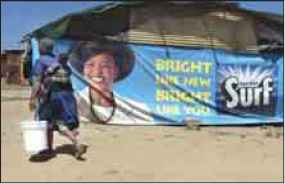Marketing to 4 Billion of the Worlds Poorest Consumers
Most multinational companies generate the majority of their sales and profits by selling products and services to consumers and businesses in highly developed countries. When they do venture into developing nations such as India or China, they have traditionally focused on urban areas where incomes are higher and communication, transportation, and distribution systems are available to implement their marketing programs. However, many multinational marketers have begun turning their attention to the 4 billion consumers who live in the remote, rural communities of developing countries. These people are yearning for a better way of life and are eager to become consumers for a variety of products.
^__While this emergent trend has been given various labels such as B2-4B (business-to-4-billion) selling, selling to the "bottom of the pyramid," or selling to pre-markets, a number of companies are recognizing that they can turn a profit while having a positive effect on people not normally considered potential consumers. However, they also realize that it is a tremendous challenge to market to these consumers. Many of the world's poor live in severe poverty, subsisting on less than $1,500 a year, and are illiterate or nearly so. They often live in tiny villages in remote areas that are completely beyond the reach of mass media and common distribution channels. Their access to and ability to use products are determined by the available infrastructure—water, roads, electricity—or lack thereof. Clearly marketers have to package, price, and distribute their products differently as well as find innovative ways to communicate with these consumers.
So how do global marketers such as Procter & Gamble and Unilever sell soap to consumers who use mud to bathe, or how do they market toothpaste to someone who uses wood from a tree to clean his teeth? These companies often start by examining the daily

lives of the consumers, including their needs, aspirations, and habits, to better understand what they may want as consumers. In many cases,advertising agencies are following or often leading their clients into these rural areas. For example, the Interpublic Group's Lowe Lintas & Partners recently set up "Linterland," an extension of its integrated marketing communications department, to help clients such as Unilever market to hard-to-reach consumers in Indonesia. Lowe's director of IMC estimates that about 64 percent of Indonesia's population (about 135 million people) lives in rural areas but can afford relatively inexpensive consumer goods such as soft drinks, shampoo, and toothpaste. The director of Linterland Indonesia notes that conventional media are not capable of reaching these rural consumers and so a different form of marketing communications—one that relies on events, road shows, and sampling—is needed to reach them.
Other ad agencies have set up similar operations to reach the vast rural populations in other Asian countries. For example, in India, 75 percent of the population (700 million people) is spread out in 600,000 villages that are virtually untouched by mass media, and they speak more than 360 dialects. WPP Group's Ogilvy and Mather launched its own special unit, Ogilvy Outreach,consisting of 35 teams in four offices that coordinate rural marketing activities across 14 states, using a network of 15,000 field-workers. Ogilvy Outreach has resorted to unusual practices such as painting cows' horns, branding water sources, organizing folk performances, and relying on schoolteachers, village heads and local health workers to relay marketing messages for clients such as Hinustan Lever, Castrol, or Amara Raja batteries. McCann-Erickson Worldwide has developed Group Asia, which specializes in rural event marketing to help its clients reach consumers in remote areas.
The most challenging country for marketers looking beyond urban markets is China, which has nearly 900 million rural consumers who are almost completely untouched by multinational marketers. In addition to the lack of knowledge regarding brands, there are problems of low income and very poor infrastructures. However, many companies are branching out into these rural areas. Word-of-mouth is the supreme marketing tool for reaching consumers in these markets, followed by education and product demonstrations. Marketers also have to adapt their products for these markets by making them available in single-use sachets that cost the equivalent of pennies rather than dollars and can be easily distributed and sold through the small kiosks found in rural villages.
Many developing countries are becoming more stable and open to trade and direct foreign investment, while education levels are also improving. The World Bank has reported that the economic growth rate for developing countries is about twice that of developed nations and is expected to reach nearly 4 percent. While investment in these markets still requires a long-term perspective, many companies are recognizing that the billions of consumers in the third world are eager to become consumers and represent a rich opportunity.
Sources: Dana James,"B2-4B Spells Profits," Marketing News, Nov. 5,2001, pp.1,11-14; Normandy Madden,"Marketing in the Field," Adage Global, October 200l,p.8.
Continue reading here: The Cultural Environment
Was this article helpful?